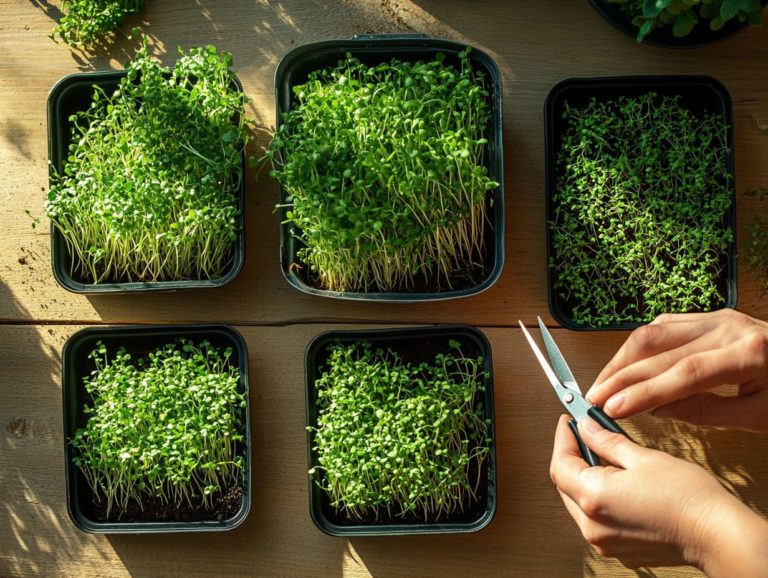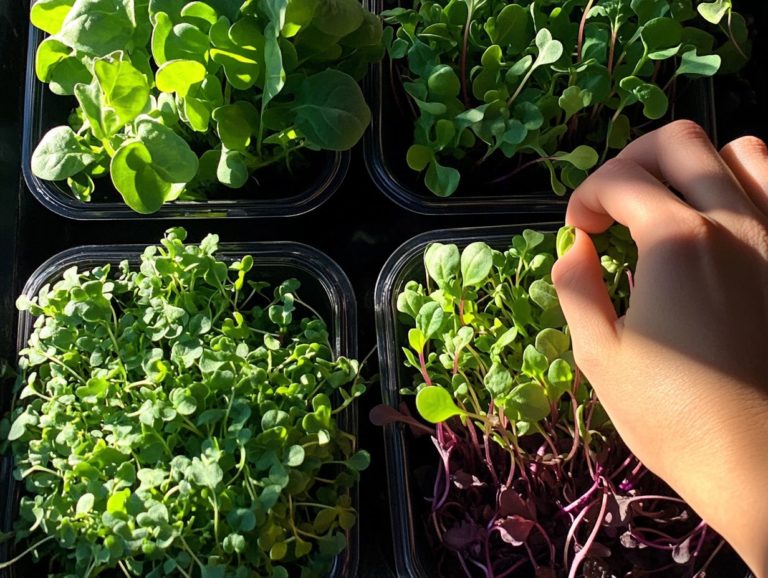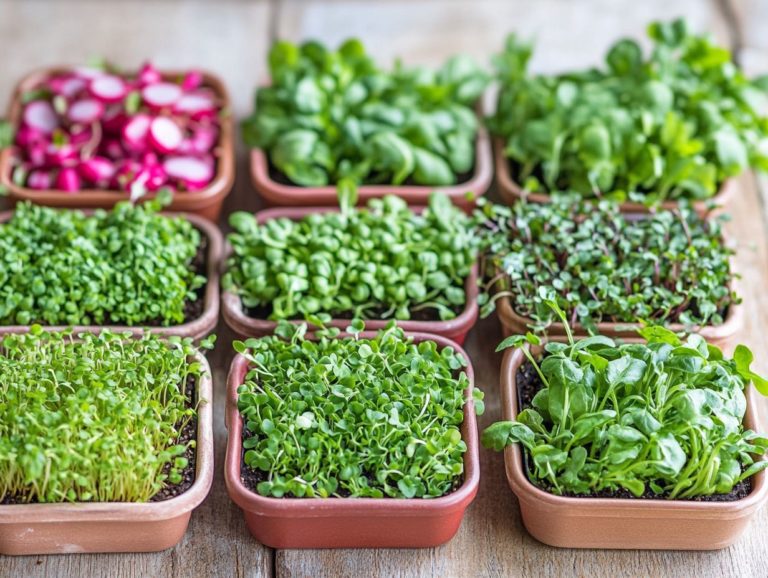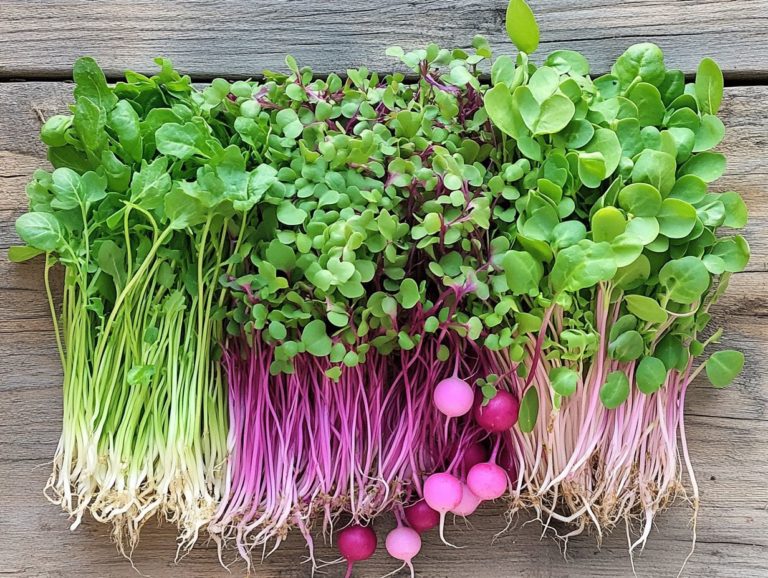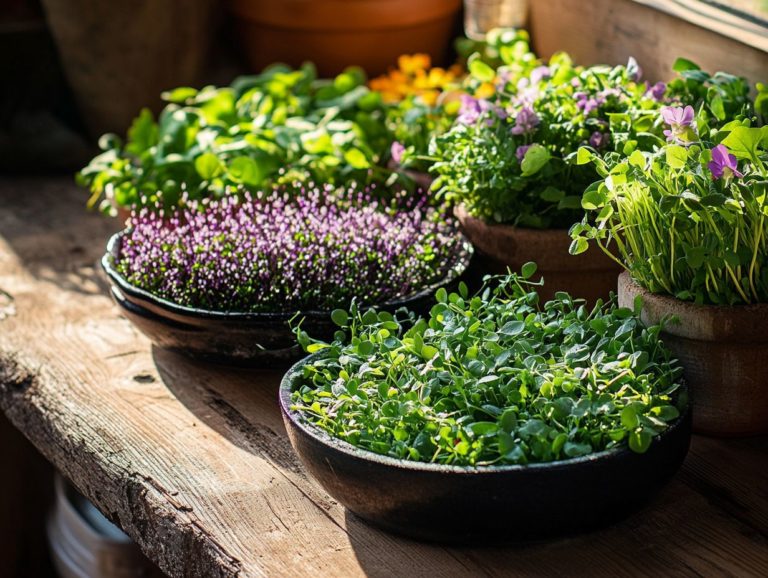How to Pair Microgreen Varieties with Dishes
Microgreens are more than trendy garnishes. They are full of flavor and nutrition, making them a valuable addition to your cooking skills.
This article explores the benefits of using microgreens in your meals. You’ll learn how to pair different varieties for the best flavor combinations.
Discover practical tips for using them creatively. Avoid common mistakes that can lessen their impact.
Prepare to elevate your dishes with these vibrant, nutrient-dense greens!
Contents
- Key Takeaways:
- Benefits of Using Microgreens in Dishes
- Pairing Microgreens with Dishes
- Tips for Using Microgreens in Cooking
- Proper Handling and Storage
- Creative Uses in Different Types of Dishes
- Common Mistakes to Avoid
- Frequently Asked Questions
- How do I choose the right microgreen variety for my dish?
- Are there any microgreen varieties that are versatile and can be paired with a wide range of dishes?
- Can I pair multiple microgreen varieties in one dish?
- Are there any specific microgreen varieties that pair well with certain types of cuisine?
- Can I use microgreens as a substitute for herbs in dishes?
- Are there any dishes or ingredients that do not pair well with microgreens?
Key Takeaways:
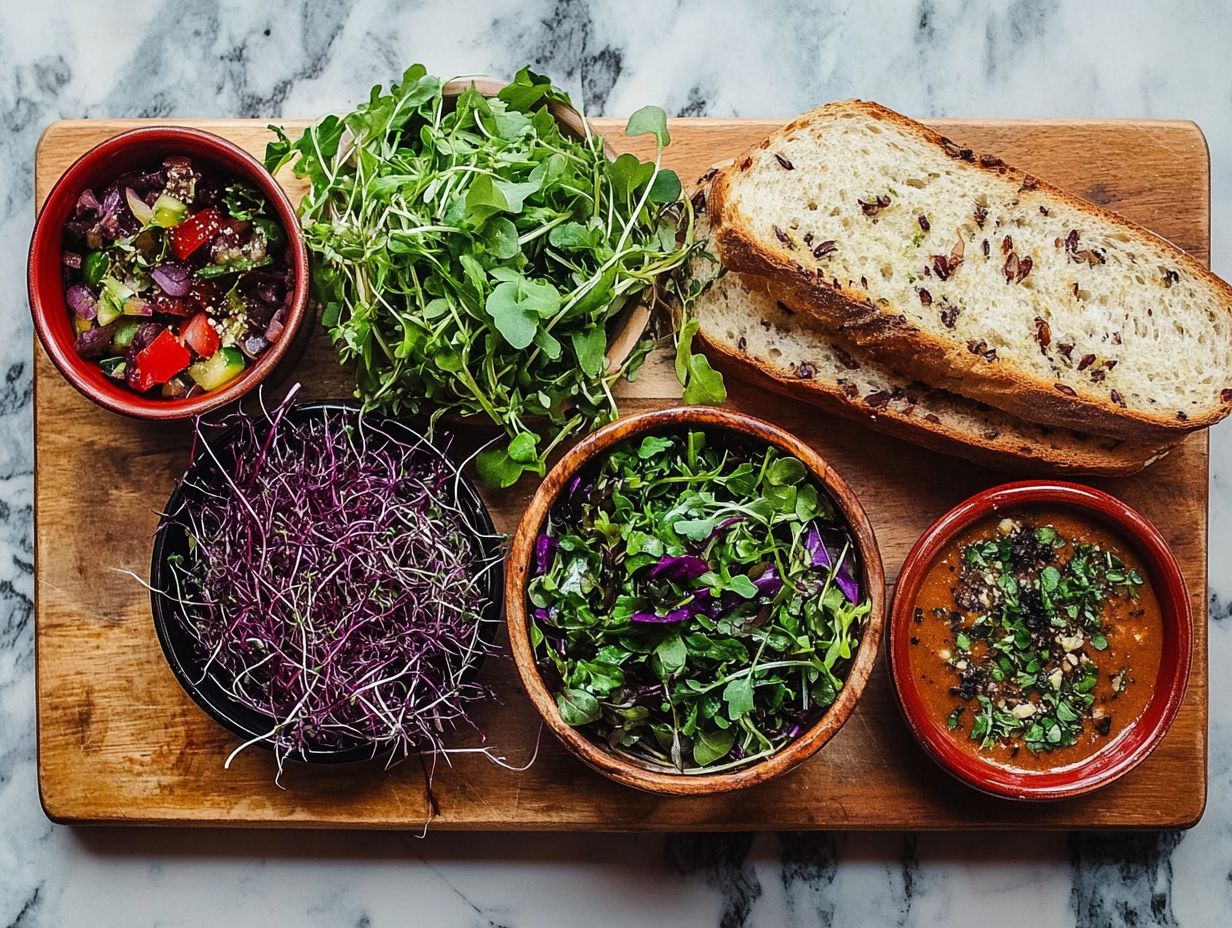
- Adding microgreens boosts flavor and looks while providing nutrition.
- Pair microgreens with dishes by matching flavors and textures.
- Proper handling and storage are crucial for freshness. Get creative but avoid overpowering flavors.
What are Microgreens?
Microgreens are young, edible plants harvested right after their first leaves appear. Examples include arugula, basil, and pea shoots tiny greens adored by chefs and home cooks.
These greens not only enhance the taste but also improve the visual appeal of your dishes. By adding microgreens to salads, sandwiches, and even cocktails, you can elevate both flavor and nutrition.
Beyond the classics, explore varieties like radish, sunflower, and mustard microgreens. Each brings a unique flavor to your meals, and they’re easy to grow indoors or outdoors, even in water instead of soil.
Sprinkle microgreens on soups, blend them into smoothies, or use them as garnishes. They add a burst of flavor and are rich in vitamins C, E, and K, plus antioxidants, making them a smart choice for any diet.
With their versatility and health benefits, microgreens are an exciting ingredient for food lovers eager to enhance flavor and nutrition.
Benefits of Using Microgreens in Dishes
Microgreens offer more than distinct flavors; they provide significant health benefits due to their rich nutrient profiles.
Packed with vitamins, minerals, and antioxidants, these tiny powerhouses boost the nutritional value of your meals. Whether in salads, sandwiches, smoothies, or soups, microgreens add vibrant colors and delicious textures.
Integrating microgreens into your cooking can improve your overall health. Dive into the world of microgreens today and transform your meals into vibrant masterpieces!
Nutritional Value
Microgreens are known for their great nutrition, often boasting higher concentrations of vitamins and minerals than their mature counterparts. Rich in essential nutrients like vitamins C, E, and K as well as powerful antioxidants these tiny greens can significantly enhance your health and improve your meals. Their diverse nutrient profiles make them an excellent choice for anyone seeking to incorporate more plant-based options into their meals. Whether you re crafting salads or salsas, learning about microgreens’ nutrients can spark your culinary creativity.
Explore the world of microgreens and discover how varieties like broccoli, arugula, and radish deliver a remarkable nutrient punch. For example, broccoli microgreens are teeming with sulforaphane, a compound that helps protect against diseases. On the other hand, arugula microgreens are a treasure trove of calcium, essential for maintaining strong bones.
It’s this impressive array of vitamins and minerals that makes these petite plants not just delicious but also vital for promoting overall wellness. By weaving microgreens into your daily meals, you can easily boost your intake of essential nutrients while savoring the delightful flavors they contribute.
Flavor and Aesthetic Enhancements
Incorporating microgreens into your culinary creations not only enhances the flavor but also adds a touch of elegance, making them a versatile ingredient across various cuisines. With their distinct flavor profiles ranging from peppery to sweet microgreens have the power to elevate everything from salads and wraps to gourmet sandwiches. Their vibrant colors and delicate textures serve as exquisite garnishes or toppings, transforming ordinary dishes into extraordinary culinary experiences. Whether you re crafting a fresh microgreens salad or garnishing tacos, their aesthetic appeal is simply undeniable.
More cooks are discovering the potential of these tiny greens. For instance, basil microgreens introduce a delightful twist to Italian dishes, providing a concentrated burst of flavor that complements pesto and marinara sauces beautifully. On the other hand, radish microgreens bring a crisp spiciness that pairs wonderfully with seafood, adding an unexpected kick to dishes like ceviche or fish tacos. For culinary professionals, exploring microgreen varieties can elevate your culinary creations.
By experimenting with different varieties, you can deepen the complexity of flavors in soups, stir-fries, or even breakfast items like omelets. Ultimately, using microgreens creatively not only boosts flavor but also adds beautiful visuals to your meals.
Pairing Microgreens with Dishes
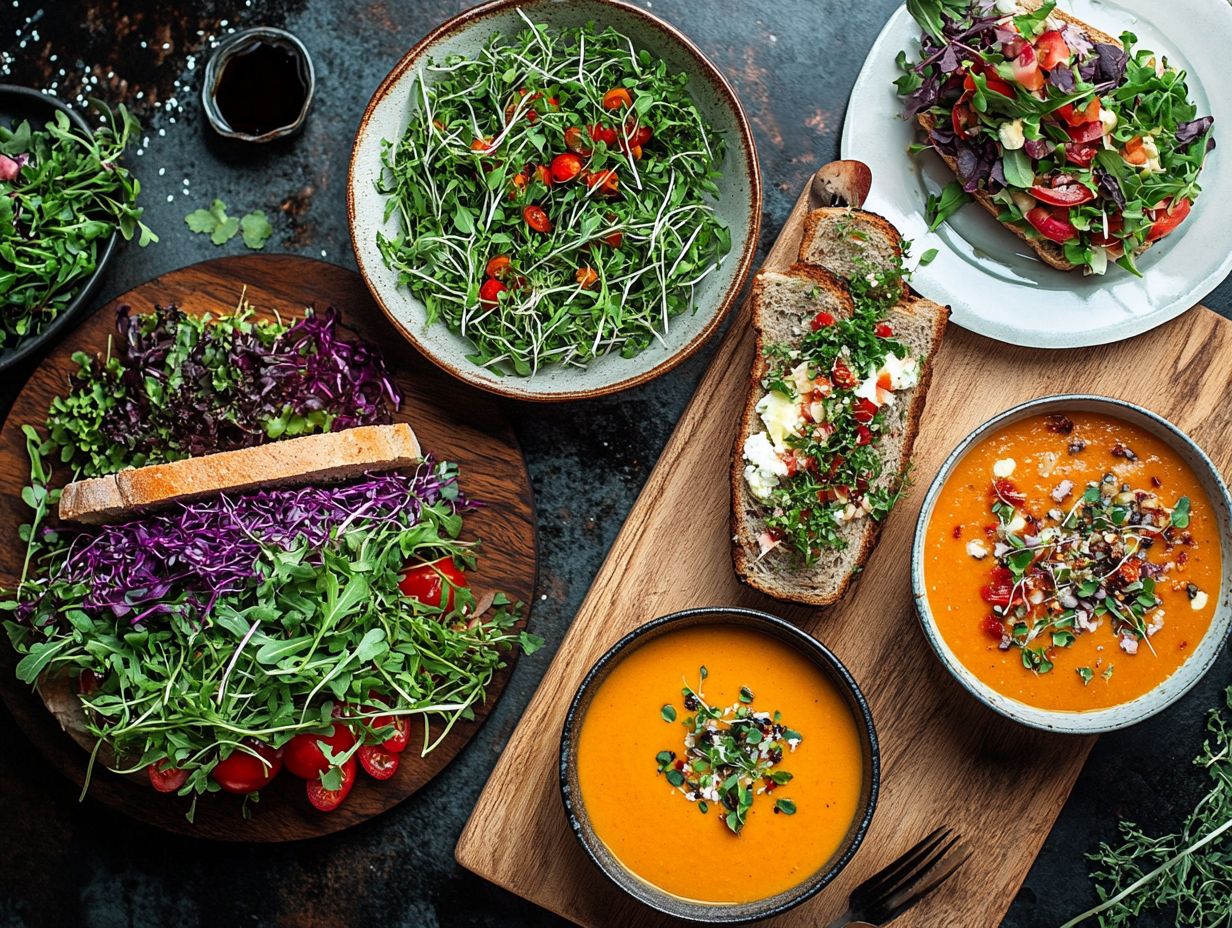
Pairing microgreens with your dishes is a skillful practice that can truly elevate your dining experience by harmonizing flavors, textures, and visual allure. The right microgreens can beautifully complement an array of dishes, whether it s a crisp salad, a hearty sandwich, gourmet tacos, or even a majestic main course.
By grasping how different microgreens interact with various ingredients, you open the door to creative culinary possibilities that enhance both taste and presentation. Delving into the seemingly limitless pairings of microgreens enables you to craft innovative meals that are sure to delight the senses.
Matching Flavor Profiles
Matching the flavor profiles of microgreens with your dishes is essential for crafting a well-balanced meal that delights the senses. Each type of microgreen has its unique flavor. For example, the spicy kick of radish microgreens contrasts with the mild sweetness of pea shoots.
Choosing the right greens is crucial. By understanding these nuances, you can create harmonious combinations that enhance the overall taste experience. For instance, exploring microgreen varieties and their flavors can help you whip up a refreshing microgreens salad or elevate a sandwich; thoughtful flavor pairing can elevate your culinary creations!
Consider how vibrant cilantro microgreens can bring a refreshing zing to shrimp tacos. The earthy notes of beet microgreens beautifully complement roasted root vegetables. If you’re preparing a delicate fish dish, topping it with watercress microgreens adds a peppery contrast that truly enhances the meal. For an even broader selection, check out must-try microgreen varieties for salads, as basil microgreens, with their sweet aromatic essence, can enrich classic pasta dishes and turn an ordinary meal into a gourmet delight!
By experimenting with these versatile greens, you ll discover their incredible potential to elevate flavors and textures. You’ll create unforgettable dining experiences!
Complementary Textures
Incorporating microgreens into your dishes not only enhances flavor but also introduces complementary textures that improve the overall dining experience. The delicate crunch of microgreens contrasts beautifully with the creaminess of dressings or the firmness of proteins, creating a delightful interplay in every bite.
Understanding how to balance textures in your meals can elevate everyday dishes. Whether you’re crafting microgreens wraps or garnishing a bowl of soup, this attention to texture can transform simple recipes into culinary masterpieces!
Imagine the vibrant, peppery kick of arugula microgreens paired with a smooth avocado spread. This combination offers a pleasing crunch that awakens your palate. Each type of microgreen brings its unique texture to the table. For instance, the soft, velvety finish of pea shoots complements grain-based salads beautifully. To explore more about different options, check out this quick guide to common microgreen varieties.
By integrating these tiny powerhouses into appetizers, salads, or even pizza toppings, you create layers of texture that captivate the senses. A light sprinkle of radish microgreens adds a refreshingly crisp bite to richer dishes, highlighting the importance of thoughtful ingredient combinations! For those looking to elevate their culinary creations, exploring the top microgreen varieties for gourmet cooking can be incredibly rewarding.
Tips for Using Microgreens in Cooking
Incorporating microgreens into your cooking skills can elevate your dishes. Mastering the art of handling and storage is essential to preserve their freshness and enhance the health benefits of your meals. These delicate greens need your care to prevent bruising, and understanding the right storage techniques will help them maintain their nutrients and taste.
Whether you’re adding them to salads, soups, or smoothies, or including them in microgreen wraps, these tiny plants are a fantastic way to boost the nutritional profile of your meals. By following a few key guidelines for using microgreens in cooking, you can unlock their full potential and savor their vibrant essence in every dish. To explore different options, check out microgreen varieties: what you need to know. Don’t miss out on elevating your dishes with these amazing greens!
Proper Handling and Storage
Proper handling and storage of microgreens are crucial for preserving their freshness and ensuring they remain a vibrant addition to your meals. Given their delicate nature, it s essential to treat them gently. Avoid bruising while washing and preparing.
Store microgreens in a cool, dry place or in a breathable container to extend their shelf life. This allows you to enjoy their health benefits for longer. Whether you re adding them to salads, soups, or as delightful sandwich toppings, maintaining their freshness is key to maximizing both flavor and nutrition.
For optimal freshness, keep microgreens refrigerated at temperatures between 0 C and 4 C. This will help slow down decay. Be mindful of moisture levels; damp microgreens can invite mold, while overly dry conditions may cause wilting. A quick rinse before placing them in a breathable container can help ensure they stay crisp without excess moisture.
When cooking with microgreens, think about adding them at the end of the cooking process. This preserves their unique textures and vibrant flavors. This enhances the dish’s appeal and ensures you don t lose those vital nutrients!
Creative Uses in Different Types of Dishes
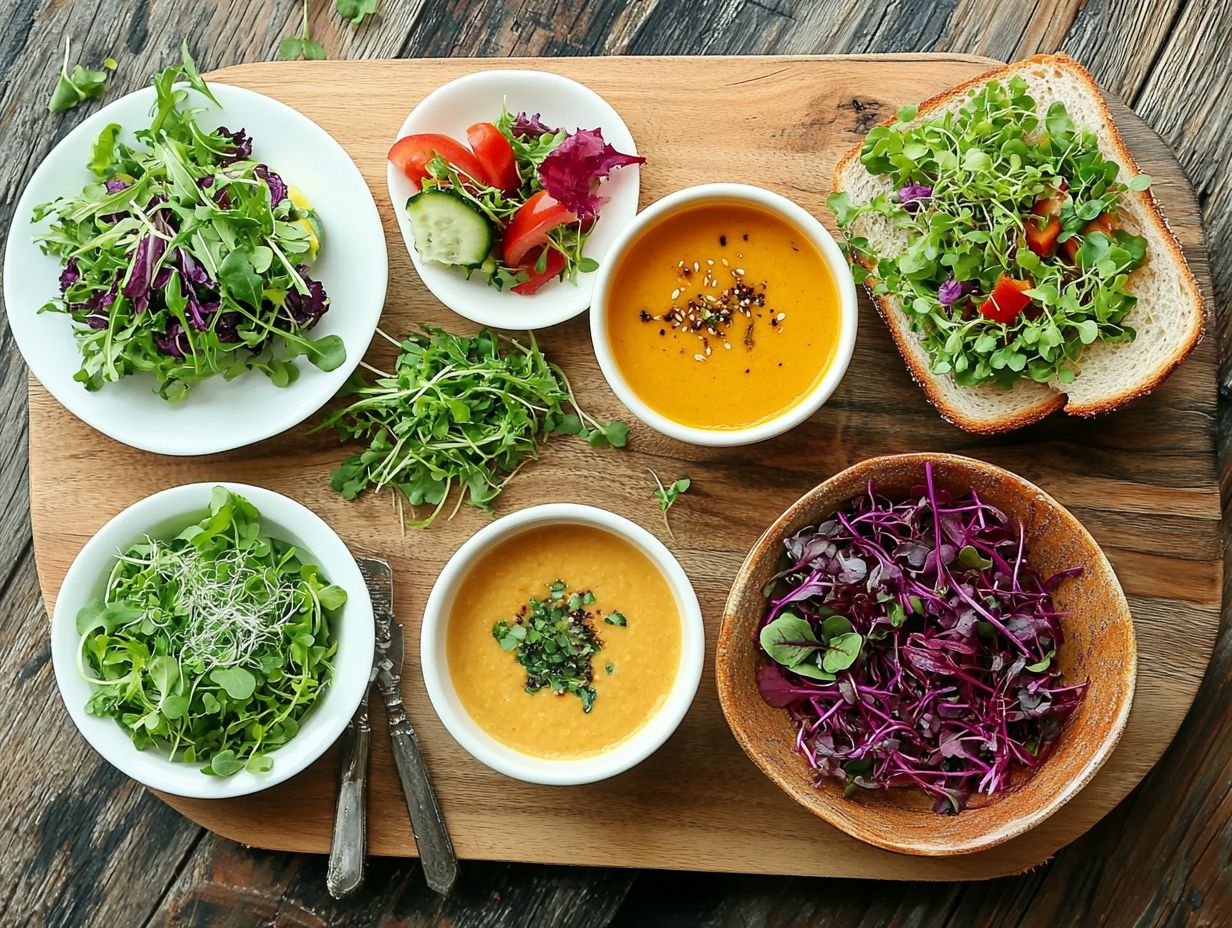
Microgreens offer a world of creative possibilities in your kitchen, making them an incredibly versatile ingredient. They bring a vibrant splash of color to your dishes, and their bold flavors can elevate everything from your morning omelet to sophisticated entr es.
Incorporating them into contemporary grain bowls adds texture and essential nutrients, making each bite delightful. Their refreshing taste can turn a simple soup into a gourmet experience, transforming your everyday meals into something extraordinary!
If you enjoy baking, consider sprinkling microgreens atop artisanal breads or sandwiches before they hit the oven. The result is a stunning presentation, especially when serving microgreens salsas paired with a unique flavor. Feel free to experiment with various varieties!
Introduce exciting elements to your appetizers, such as microgreens-infused dips or using them as sandwich toppings. They also make a vibrant garnish for tacos and can be used in microgreens smoothies for desserts, delighting both the eyes and the palate.
Common Mistakes to Avoid
Recognizing common mistakes when using microgreens can save you from cooking mistakes and help you fully harness their potential in your dishes. It s easy to overpower the delicate flavors of microgreens with excessive seasoning or by pairing them with ingredients that clash.
Improper handling and storage can compromise freshness and nutritional value. By being mindful of these pitfalls, you can make informed choices that elevate your cooking experience, allowing the vibrant taste of microgreens and their health benefits to truly shine!
Overpowering Flavors
One common misstep you may discover when using microgreens is overshadowing their delicate flavors with robust seasonings or bold ingredients. While they add a bright touch to your dishes, microgreens are inherently delicate and can be easily overwhelmed by more assertive flavors. To achieve a harmonious balance, it’s essential to pair them with complementary ingredients that enhance their natural taste rather than mask it. This thoughtful approach not only preserves their flavor but also elevates your overall cooking experience, especially when experimenting with microgreen techniques.
For the best results, consider opting for mild dressings and fresh herbs to complement their flavors, along with simple seasonings that highlight the unique notes of each microgreen variety. Fresh herbs and citrus juices or light vinaigrettes can enhance flavors without overpowering them. Incorporating elements like light oils, nuts, or soft cheeses can create a delightful contrast, enhancing both texture and taste. Additionally, exploring ways to enhance flavor in microgreens can elevate your dishes even further.
Balancing flavors is about exploring combinations and allowing the inherent qualities of microgreens to shine, resulting in dishes that are both flavorful and subtle. For those interested in growing microgreens, consider checking out microgreen varieties: a guide for beginners.
Incompatible Pairings
Using microgreens incorrectly often happens when you pair them with ingredients that clash with their delicate flavors and textures. Some ingredients simply don t complement the unique characteristics of certain microgreens, resulting in a dish that fails to highlight their potential. It’s essential to consider the flavor profiles and textures of both the microgreens and other ingredients when crafting your culinary masterpieces.
By steering clear of incompatible combinations, you can truly let microgreens shine in your creations.
Take arugula microgreens, for example. Their vibrant, peppery flavor is ideal for tacos but can easily be overwhelmed by rich or heavy sauces, such as creamy Alfredo. Instead, these greens flourish with lighter dressings that accentuate their benefits, like a citrus vinaigrette, which enhances their flavor rather than masking it.
Similarly, pairing sweet microgreens, like sweet pea shoots, with savory ingredients such as aged cheeses may create a clash that detracts from the overall dish. Opting for fresh fruits, especially in salads, or light protein sources allows for a harmonious balance, letting the natural flavors come through.
Understanding these nuanced interactions can elevate your cooking experience to new heights.
Experimenting with Microgreens in Your Own Kitchen
Experimenting with microgreens in your kitchen opens the door to a world of cooking fun and allows you to expand your repertoire with dishes like pesto and wraps.
As you immerse yourself in the vibrant realm of these tiny greens, you’ll uncover the benefits of growing diverse microgreen varieties that can transform everyday meals with surprising bursts of flavor and nutrition. With a dazzling array of colors and tastes, microgreens inspire creativity, encouraging you to try new recipes and cooking techniques.
For example, imagine blending them into smoothies for a refreshing boost or using their delicate textures to craft striking garnishes that will surely dazzle your dinner guests. The joy is in the exploration each handful of microgreens presents an opportunity to infuse your dishes with fresh ideas and delightful surprises.
Frequently Asked Questions
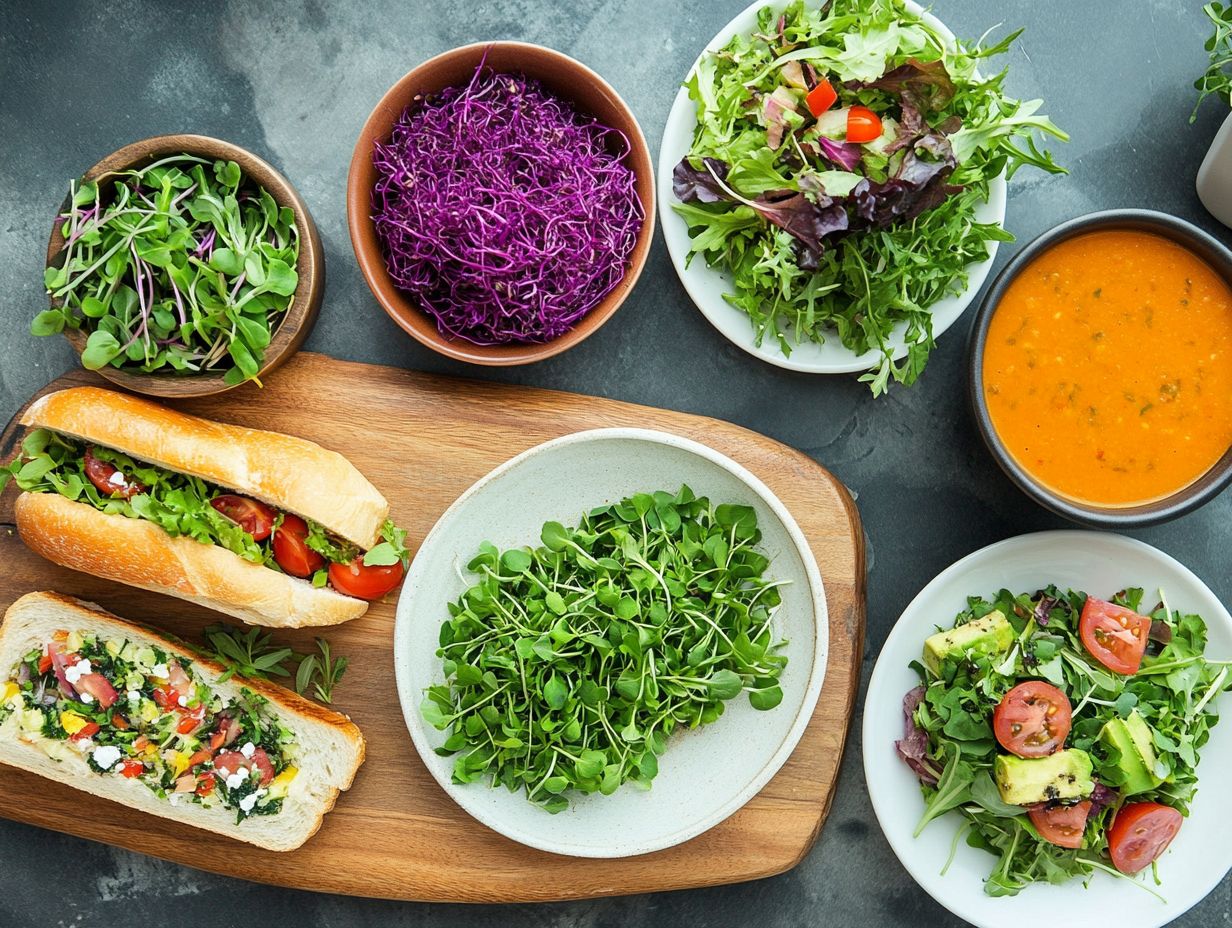
How do I choose the right microgreen variety for my dish?
Think about what flavors you want in your dish first, then choose a microgreen variety that complements or enhances those flavors. For example, peppery microgreens like arugula or mustard pair well with savory dishes, while citrusy microgreens like lemon balm or sorrel work well in salads or seafood dishes.
Are there any microgreen varieties that are versatile and can be paired with a wide range of dishes?
Yes! Microgreens like sunflower, broccoli, and pea shoots are versatile. They add a fresh crunch without overpowering your dish.
Can I pair multiple microgreen varieties in one dish?
Absolutely! Combining different microgreen varieties adds more flavor to your dish. Choose varieties that complement each other.
Are there any specific microgreen varieties that pair well with certain types of cuisine?
Dive into your favorite cuisines! Cilantro and basil microgreens are amazing in Mexican and Italian dishes.
Can I use microgreens as a substitute for herbs in dishes?
Yes, microgreens can replace fresh herbs beautifully. They bring color and freshness, but remember to adjust the amount since they can be stronger in flavor.
Are there any dishes or ingredients that do not pair well with microgreens?
Microgreens enhance many dishes, but they may clash with strong flavors. For instance, avoid pairing them with dishes that have overpowering vinegar or citrus.

